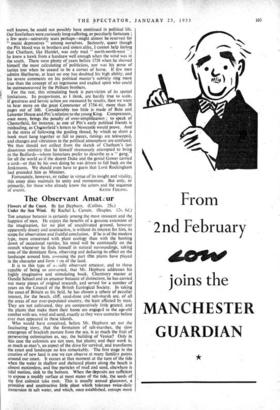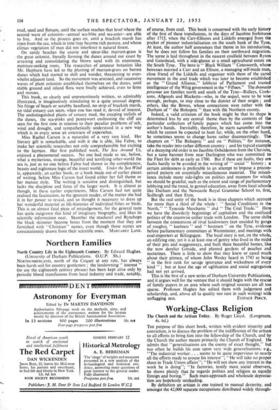The Observant Amateur
Flowers of the Coast. By Ian j-lepburn. (Collins. 25s.) Under the Sea Wind. By Rachel L. Carson. (Staples. 12s. 6d.)
THE amateur botanist is certainly among the most innocent and the happiest of men. He enjoys the benefits of a genuine extension of the imagination, for no plot of uncultivated ground, however apparently dreary and unattractive, is without its interest for him, its scope for observation and fruitful conclusion. If he is of the modern type, more concerned with plant ecology than with the hunting down of occasional rarities, his mind will be continually on the stretch whenever he finds himself in natural surroundings, taking note of the dominant flora, observing and deducing its effect on the landscape around him, assessing the part tliat plants have played in the character and form t on of the land.
It is to this type of u observant amateur, and to those capable of being so converted, that Mr. Hepburn addresses his highly imaginative and stimulating boolc. Chemistry master at Oundle School and an amateur botanist of distinction, he has carried out many pieces of original research, and served for a number of years on the Council of the British Ecological Society. In taking the coast of Britain as his field, he has chosen a sphere of peculiar interest, for the beach, cliff, sand-dune and salt-marsh are, of all the areas of our over-populated country, the least affected by man. They are not cultivated, they are comparatively little grazed, and the plants that make them their home are engaged in the age-old combat with sea, wind and sand, exactly as they were centuries before ever man appeared in these islands.
Who would have conceived, before Mr. Hepburn set out the fascinating story, that the formation of salt-marshes, the slow emergence of brackish pasture from the sea, is as much the fruit of persevering colonisation as, say, the building of Venice? Only in this case the colonists are not men, but plants; and their work is, as much as man's, an aspect of the drive for survival, and transforms the coast and landscape no less remarkably. The first stage in the creation of new land is one we can observe at many familiar points around our coast. It occurs at that moment at the turn of the tide when the water in shallow and sheltered places along the beach is almost motionless, and fine particles of mud and sand, elsewhere is tidal motion, sink to the bottom. When the deposits are sufficient to expose a muddy surface at most states of the tide, the seeds of the first colonist take root. This is usually annual glasswort, a primitive and unattractive little plant which tolerates twice-daily immersion in salt water, and which, once established, entraps more
mud, sand and flotsam, until the surface reaches that level where the second wave of colonists—annual sea-blite and sea-aster—are able to live. And so the process goes on, until a brackish marsh has risen from the sea, which in time-may become rich pasture, and whose climax vegetation (if man did not interfere) is natural forest.
On sandy beaches the coarse and spear-like marram-grass is .the great colonist, literally forming the dunes around our coast by arresting and consolidating the blown sand with its enormous, moisture-seeking roots. The researches of amateur botanists like Mr. Hepburn have led to the planting of marram-grass on barren dunes which had started to shift and wander, threatening to over- whelm adjacent land. So the movement was arrested, and successive waves of plant colonists established themselves on the dunes, until stable ground and inland flora were finally achieved, even to ferns and mosses.
This book, so clearly and unpretentiously written, so admirably illustrated, is imaginatively stimulating to a quite unusual degree. No fringe of beach or, scrubby headland, no strip of brackish marsh, no tidal estuary can seem, when one has read it, devoid of interest. The undistinguished plants of estuary mud, the creeping trefoils of the dunes, the sea-pinks and pennywort cushioning the cliff are seen for the first time in relation to their peculiar problems of salt, wind and drought, and sympathetically understood in a new way which is in every sense an extension of experiehce.
Miss Rachel Carson is a naturalist of a very rare kind. Her literary gift is remarkable, and with it she is able, like Fabre, to 'make her scientific researches not only comprehensible but exciting to the layman. Her first published work, The Sea Around Us, enjoyed a phenomenal success. No one had made us see, before, what a mysterious, strange, beautiful and terrifying other-world the sea is, just as no one before Fabre had shown us the completeness, beauty and nightmare logic of the insect world. Under the Sea Wind is, apparently, an earlier book, or a book made out of earlier pieces of writing, before Miss Carson had found either her full theme or her mature style. The writing is sensitive and distinguished, but lacks the discipline and force of the larger work. It is almost as though, in these earlier experiments, Miss Carson had not quite realised the fascination, to the ignorant reader, of the matter she had it in her power to reveal, and so thought it necessary to dress up her wonderful material as life-histories of individual fishes or birds. This is an almost fatal piece of misjudgement, for the general taste has quite outgrown this kind of imaginary biography, and likes its scientific information neat. Skomber the mackerel and Rynchops the black skimmer become bores from the moment that they are furnished with "Christian" names, even though those names are conscientiously drawn from their scientific ones. MARGARET LANE.



































 Previous page
Previous page